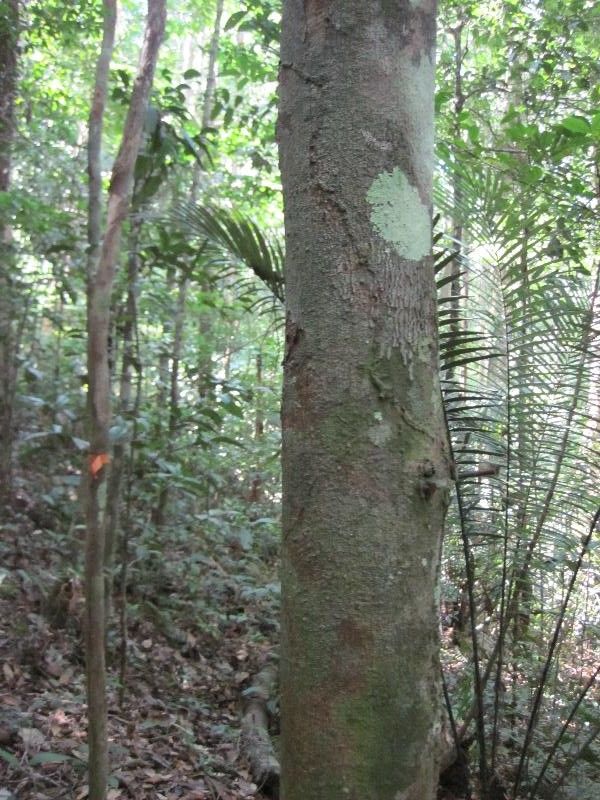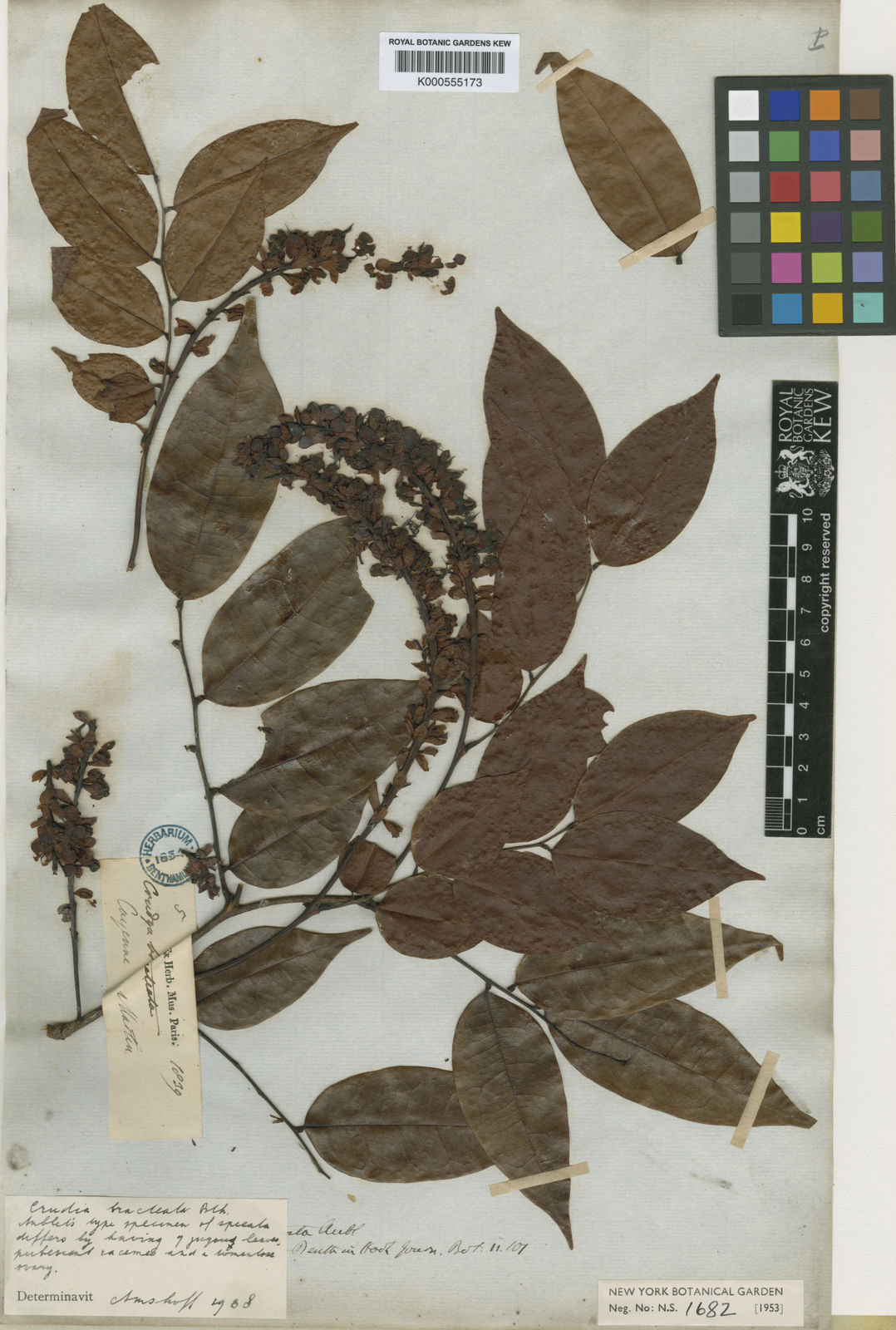unknown
crudia bracteata
Also known as: []
Overview
A species of flowering plant in the family Fabaceae, native to tropical regions.
Benefits & Perks
["rare/collector’s item"]
Botanical Classification
| Phylum: | Magnoliophyta |
| Class: | Magnoliopsida |
| Order: | Fabales |
| Family: | Fabaceae |
| Genus: | Crudia |
| Botanical Name: | Crudia bracteata |
Plant Characteristics
Basic Information
- Category: Trees
- Suitable Location: indoor pot in a bright, humid room or shaded outdoor garden
- Suitable For:
- Is Weed: No
- Allergenicity: unknown
Environmental Needs
- Climate: {"temperatureRange":"18–30°C"}
- Hardiness: {"zones":"9–11"}
- Misting: every 2–3 days to maintain moderate humidity, especially in dry environments
- Drainage: Fast-draining to prevent waterlogging.
- Soil Type: Well-draining potting mix with added organic matter like compost or peat moss.
Maintenance Level
- Maintenance Level: unknown
- Toughness Level: unknown
- Pruning Frequency: Light pruning as needed; major pruning in late winter or early spring before new growth.
- Pruning Intensity: Light to moderate; avoid heavy pruning unless necessary for health or shape.
Care Details
Ideal Sunlight Coverage:
Bright indirect light for 6–8 hours daily; adjust to partial shade during intense summer months.
Sunlight Tolerance Tips:
Acclimate gradually to direct light; protect from harsh afternoon sun; place in filtered light indoors or dappled shade outdoors.
Care Requirements
Care Difficulty
unknownmoderate
Sunlight
partial shade to dappled sunlight
Rotate plant for even light exposure; use sheer curtains to filter intense light; avoid sudden light changes.
Watering
every 7–10 days during active growth, reducing to every 14–21 days in dormancy
Water deeply to encourage root growth; ensure proper drainage to avoid waterlogging; adjust frequency based on season and humidity.
Soil
well-draining, rich organic potting mix
pH: Slightly acidic to neutral (pH 5.5–7.0).
Use a mix with good aeration; avoid heavy clay soils; check drainage before planting.
Temperature
Prefers 65–85°F (18–29°C); cooler temperatures (55–60°F or 13–15°C) tolerated at night; avoid frost.
Use a thermometer to monitor; group plants for microclimate benefits; avoid drafts.
Fertilizing
every 4–6 weeks during spring and summer with balanced liquid fertilizer, none in winter
Fertilize after watering to prevent root burn; flush soil occasionally to prevent salt buildup; match fertilizer to plant needs.
Propagation
Methods
Stem cuttings or division; stem cuttings are more common for home growers.
Step-by-Step Propagation Guide
- Take a healthy cutting, apply rooting hormone, plant in medium, maintain humidity, and wait for roots.
Best Time: Spring or early summer when the plant is actively growing.
Environment
High humidity (70–90%), warm temperatures (75–85°F or 24–29°C), and indirect light.
Medium
Well-draining mix of peat and perlite or cactus mix.
Hormone
Rooting hormone recommended for faster and more reliable rooting.
Timeline
Roots may develop in 4–8 weeks; new growth in 2–3 months.
Tools Needed
Pruning shears, rooting hormone, propagation tray, humidity dome, well-draining medium.
Quick Tips
Use sterile tools to prevent disease; maintain consistent moisture; provide bottom heat for faster rooting.
Pruning & Repotting
Pruning Guide
Method
Use clean cuts just above a leaf node or branch junction; remove crossing or crowded branches.
Pruning Plan
Prune to maintain shape, encourage bushier growth, and remove dead or diseased parts.
Tools
Pruning shears, sterilizing solution, gloves.
Checklist
Sterilize tools, prune dead/damaged parts, shape the plant, clean up debris, monitor for recovery.
Repotting Guide
Best Season
Early spring before active growth begins.
Pot Size
Choose a pot 1–2 inches larger in diameter than the current one.
Method
Remove plant gently, trim roots if needed, place in new pot with fresh soil, water lightly.
Suggestions
Repot every 2–3 years or when roots fill the pot; necessary to refresh soil and provide space.
Checklist
Check root bound status, prepare new pot, trim roots if necessary, use fresh soil, water lightly, place in appropriate light.
Advanced Care Tips
Watering Mastery
Watering Checklist
Check soil moisture, water deeply, ensure drainage, avoid foliage wetting, adjust for season.
How to Apply Water Properly
Water directly at the root zone until water drains from the bottom; avoid wetting foliage to prevent fungal issues; water in the morning to allow foliage to dry.
Watering Schedule Tips
Water thoroughly when the top inch of soil feels dry; reduce frequency in winter to prevent root rot.
Soil Improvement
Add perlite or coarse sand for drainage; incorporate compost for fertility; ensure aeration with chunky materials.
Temperature Stress Management
Signs of Temperature Issues
Leaf drop, yellowing, stunted growth, or bud drop in extreme conditions.
Cold Stress
Slows growth, causes leaf discoloration, and may lead to root damage in prolonged cold.
Solution: Move to a warmer location, insulate roots with mulch, and avoid overwatering in cold conditions.
Hot Stress
Wilting, leaf scorch, or leaf drop due to excessive heat and dryness.
Solution: Provide shade, increase humidity, and water more frequently during heatwaves.
Fertilizing Guide
Fertilizing Checklist
Check season, dilute correctly, water before feeding, avoid foliage contact, flush periodically.
Fertilizing Method
Use balanced liquid fertilizer diluted to half strength every 4–6 weeks during growing season (spring/summer); cease in fall/winter.
Common Problems & Solutions
Toxicity Warning
Cats
Non-toxicCrudia bracteata is not known to be toxic to cats. There are no reported instances of toxicity following ingestion or contact.
⚡ Toxic If:
None
Dogs
Non-toxicCrudia bracteata is not known to be toxic to dogs. There are no reported instances of toxicity following ingestion or contact.
⚡ Toxic If:
None
Humans
Non-toxicCrudia bracteata is not known to exhibit toxic properties to humans. There are no documented cases of adverse effects from ingestion or contact.
⚡ Toxic If:
None
Frequently Asked Questions
Q: Is Crudia bracteata commonly cultivated?
A: No, it is rare and primarily of interest to collectors and botanists.
Q: What is the natural habitat of Crudia bracteata?
A: It is native to tropical regions, typically found in forested areas.
Q: Does Crudia bracteata have any known uses?
A: Limited information is available, but it is not widely used for medicinal or culinary purposes.
Quick Reference
| Family: | Fabaceae |
| Care: | unknown |
| Light: | partial shade to dappled sunli |
| Water: | every 7–10 days during activ |
Get Expert Care Tips
Download the Plantious app for personalized care reminders and plant identification!
Google Play App Store





